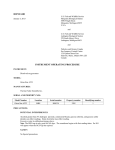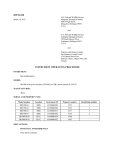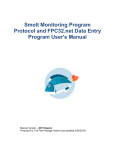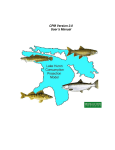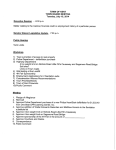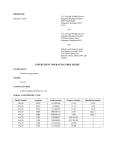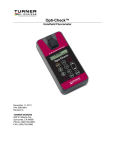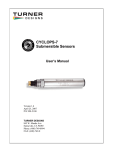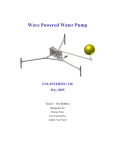Download IOP:004.3B INSTRUMENT OPERATING PROCEDURE
Transcript
IOP:004.3B U.S. Fish and Wildlife Service Marquette Biological Station 3090 Wright Street Marquette, Michigan 49855 U.S.A. January 12, 2012 and U.S. Fish and Wildlife Service Ludington Biological Station 229 South Jebavy Drive Ludington, Michigan 49431 U.S.A. and Department of Fisheries and Oceans Sea Lamprey Control Centre 1219 Queen Street East Sault Ste. Marie, Ontario P6A 2E5 Canada INSTRUMENT OPERATING PROCEDURE INSTRUMENT: Fluorometer MODEL: Model 10-AU-005-CE MANUFACTURER: Turner Designs SERIAL AND PROPERTY NOS: Model number Location Serial number Property number Identifying number 10-AU-005-CE LBS 6406xxx US 392266 – PRECAUTIONS: POTENTIAL INTERFERENCES No known interferences SAFETY No special safety precautions PROCEDURES: I. II. Installation A. Place the instrument on a vibration free laboratory counter. B. Connect power cord to instrument and to outlet. The unit will also run with power from a 12 volt battery if required. Instrument Components A. B. Controls and indicators 1. Sensitivity: Sets the basic sensitivity of the unit. This procedure is done the first time before calibration and is locked in place (5/32 Allen screw). 2. Blank: Is used to compensate for the residual or “blank” fluorescence corresponding to zero concentration of the unknown. 3. Span: During calibration, minor adjustments may be made to sensitivity with the span function 4. Auto-ranging function: Will select the appropriate instrument range for the standard and blank. Instrument ranges (high, medium, and low) are in factors of 10. You also have the option of setting the instrument to manual and selecting the range for the blank and standard. 5. Range alarm indicators: These indicate the selected sensitivity. Cuvette system 1. III. A single-sample cell (cuvette) is used for measurement of individual samples (discrete sampling). Calibration A. The calibration process is completed only once; the information is stored within the instruments memory. Once calibrated, drift is less than 0.5%. B. Prior to use, prepare a standard that is ~ 80% of the highest concentration that you may encounter, but still within the linear range. C. Turn unit on and wait 10 minutes for instrument to warm up. D. Access the calibration menu, screen 2.0. Set the concentration range to Auto. Enter the concentration for your standard. E. If you want the instrument to subtract a blank, set screen 2.12 to yes. F. Measure the blank to determine blank range. The auto range mode will automatically select the appropriate range, generally the lowest range. Access Run Blank from screen 2.11. While on screen 2.11, wait until the reading is stable. Then, if the blank is less than 200%, press<0>. Remove the cuvette and set aside. IV. G. Run standard to determine the standard range (access Run Standard screen 2.3). The auto range function will select the best standard range for the instrument that will ensure the optimum resolution. Note: the best accuracy and resolution is attained on low and medium ranges. In all cases, regardless of range selection, the concentration of the standard must be within the linear range of the instrument for the dye being analyzed. H. Return to the Home screen and analyze samples. The dye concentration of each sample will be displayed digitally (ug/L). Operation A. Turn on power switch. B. Allow the instrument to warm up for 10 minutes. Set the basic operating level. C. Calibrate the instrument (see section III.) The calibration should be checked periodically to ensure accuracy/precision and to detect drift. D. Pour a stream blank sample into a cuvette. This reading can be subtracted from sample readings to compensate for background. E. Record the temperature of the samples for temperature compensation if greater precision is needed. MAINTENANCE: I. II. General Maintenance and Repair A. Instrument is kept clean and out of dusty areas or areas with temperature and humidity extremes. Make sure cuvettes are clean/clear and dry before use. B. The sample compartment should be air tight to prevent condensation on the cuvette. If the unit is moved from a cold to a hot humid area, the unit may fail to operate correctly. Leave instrument on and the condensate will evaporate in about 15-20 minutes. C. Little can be done by the operator to repair a malfunction. It is recommended that the unit be returned to a service technician for repair. Documentation A. Note all instrument malfunctions. B. Note all repairs conducted on the fluorometer. REFERENCE: Operating and Service Manual for the Model 10-AU-005-CE Fluorometer user’s manual, April 1999 Part Number 10-AU-074 Service department: Turner Designs 845 W. Maude Ave. Sunnyvale, CA. 94086 This procedure has been reviewed and approved by the undersigned representative of the U.S. Fish and Wildlife Service. REVIEWED/APPROVED______________________________ Field Supervisor (U.S.) DATE____________




